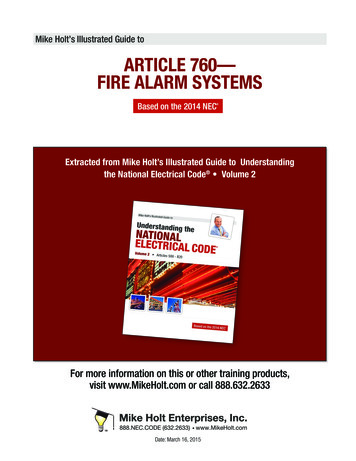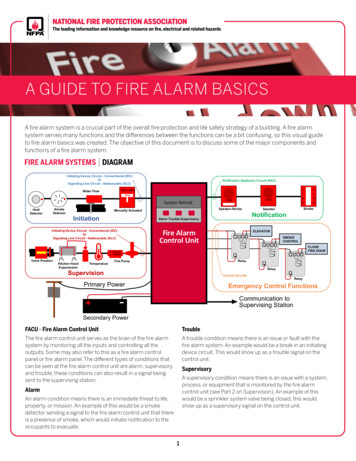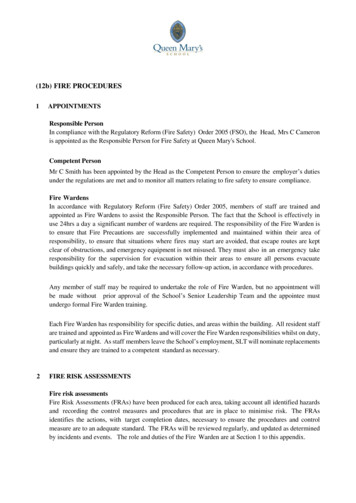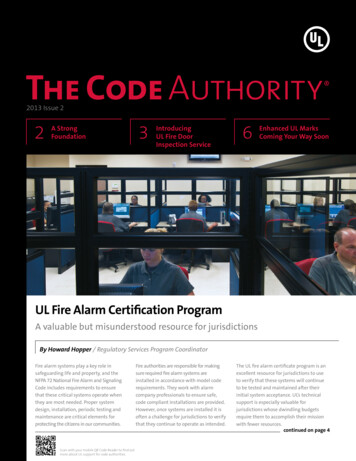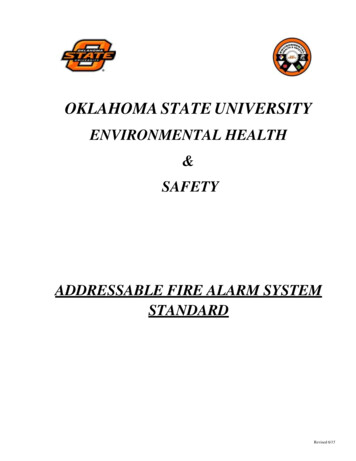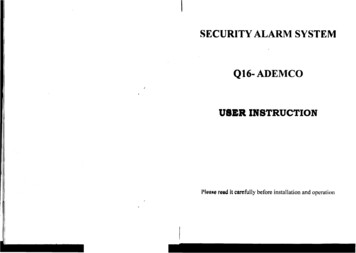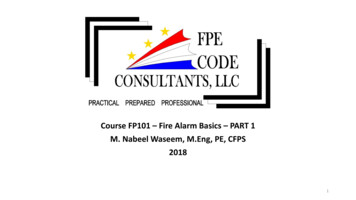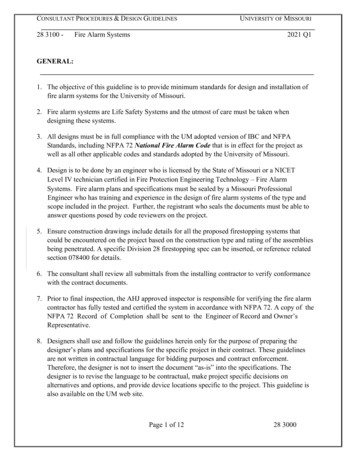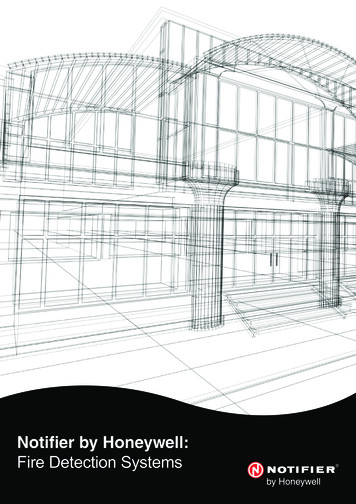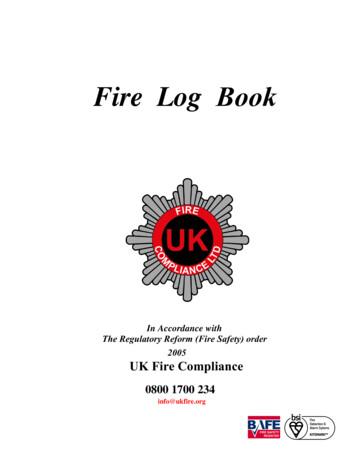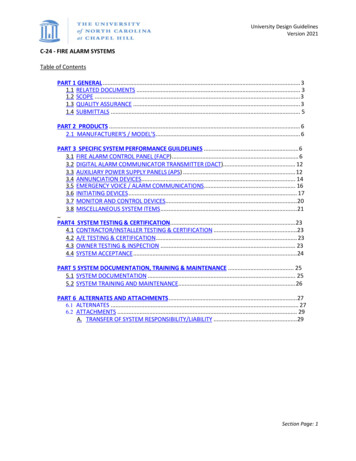
Transcription
University Design GuidelinesVersion 2021C-24 - FIRE ALARM SYSTEMSTable of ContentsPART 1 GENERAL . 31.1 RELATED DOCUMENTS . 31.2 SCOPE . 31.3 QUALITY ASSURANCE . 31.4 SUBMITTALS . 5PART 2 PRODUCTS . 62.1 MANUFACTURER'S / MODEL’S . 6PART 3 SPECIFIC SYSTEM PERFORMANCE GUILDELINES . 63.1 FIRE ALARM CONTROL PANEL (FACP) . 63.2 DIGITAL ALARM COMMUNICATOR TRANSMITTER (DACT). 123.3 AUXILIARY POWER SUPPLY PANELS (APS) . 123.4 ANNUNCIATION DEVICES. 143.5 EMERGENCY VOICE / ALARM COMMUNICATIONS. 163.6 INITIATING DEVICES . 173.7 MONITOR AND CONTROL DEVICES. 203.8 MISCELLANEOUS SYSTEM ITEMS . 21.PART4 SYSTEM TESTING & CERTIFICATION. 234.1 CONTRACTOR/INSTALLER TESTING & CERTIFICATION .234.2 A/E TESTING & CERTIFICATION. 234.3 OWNER TESTING & INSPECTION . 234.4 SYSTEM ACCEPTANCE .24PART 5 SYSTEM DOCUMENTATION, TRAINING & MAINTENANCE . 255.1 SYSTEM DOCUMENTATION . 255.2 SYSTEM TRAINING AND MAINTENANCE. 26PART 6 ALTERNATES AND ATTACHMENTS .276.1 ALTERNATES . 276.2 ATTACHMENTS . 29A. TRANSFER OF SYSTEM RESPONSIBILITY/LIABILITY .29Section Page: 1
University Design GuidelinesVersion 2021FIRE ALARM SYSTEMPART 1 - GENERAL1.1 RELATED DOCUMENTSA. Drawings and general provisions of Contract, including General and SupplementaryConditions and Division-1 Specification sections, apply to work of this section.1.2 SCOPEA. This section of the specifications includes the furnishing, installation, and connection of themicroprocessor controlled, addressable reporting fire alarm equipment required to form acomplete coordinated system ready for operation. It shall include, but not be limited to,alarm initiating devices, alarm notification appliances, control panels, auxiliary controldevices, annunciators, power supplies, and wiring as shown on the drawings and specifiedherein. It also includes the connections and appurtenances necessary to interconnect withthe existing system as described above.B. The University maintains and services all fire alarm equipment on campus. The Contractorshall provide any site specific and end user type training of the system. Additionally, whereany specific computers, printers, cabling, software and/or license agreements are necessaryfor the University to have the capability to develop a database and/or modify any operatingscenario for the buildings fire alarm system without permission from outside distributors, aschedule of available manufacture certification training shall be provided. This training andcertification shall recognize the University as a trained and licensed Fire Alarm Systeminstaller independent of local distributors and shall not be included in the price of the basebid. The authorized representative will coordinate training arrangements, costs, and specificsupport equipment needs with the owner.1.3 QUALITY ASSURANCEA. Manufacturer's Qualifications: Firms regularly engaged in manufacture of fire alarm systemsof types, sizes, and electrical characteristics required, and whose products are Listed andLabeled by UL, Inc. All products, including initiating devices and notification appliances, shallbe as produced or supplied by the same manufacture as the main fire alarm control panel.Products of firms that do not maintain factory authorized service organization and spareparts stock are not acceptable for use on this project.Manufacturer’s shall agree to make factory training/certification, product programs and/oroperating systems, and continued product updates and/or Tech notes available to theUniversity. Any licensing and/or proprietary agreements between themanufacture/distributor and the University must be completed and in place prior to themanufacture and/or product being acceptable for installation.B. Installer’s Qualifications: An experienced company who is an authorized representative ofthe FACP manufacturer for both installation and maintenance of all equipment is requiredSection Page: 2
University Design GuidelinesVersion 2021for installation of the FACP and connection of all circuits for any project. The Installer shallhave a minimum of 5 years documented experience installing fire detection and alarmsystems similar in size and scope to this project. The Installer technicians shall be individuallycertified NICET Level 2 and by the manufacturer of the equipment and trained and certifiedon the specific model being installed. The Installer shall have at least one technician on staffcertified NICET Level 3. Certifications shall be current to latest release and must haveoccurred in the most recent 24 months. All connections to the FACP, systemprogramming, and/or programming changes shall be accomplished only by the Installertechnicians compliant with qualifications, and must be present for the 100% test, Engineer’sinspection, and Owner inspections.C. Codes and Standards: The codes and standards listed below are utilized as design criteria for“minimal” system coverage. The University may require additions to these codes andstandards based on historical consensus criteria for design and installation of fire alarmsystems specific to facility applications within University type settings.1. NFPA Compliance: Comply with current applicable requirements of NFPA-72, NationalFire Alarm Code.2. NEC Compliance: Comply with current applicable requirements of NFPA-70, NationalElectrical Code (NEC) standards pertaining to fire alarm systems.3. State Building Code Compliance: Comply with applicable requirements of the NorthCarolina State Building Code.4. NC Department of Insurance: Comply with current Office of State Fire Marshal FireDetection and Alarm Systems, and Fire Sprinkler Systems.5. Testing Laboratory Compliance: Comply with provisions of UL safety standardspertaining to fire alarm systems. Provide products and components, which are Listedand Labeled.6. FM Compliance: Provide fire alarm systems and accessories, which are FM approved.7. Comply with Authority(ies) Having Jurisdiction (AHJ):a) NC State code requirement issues: NC State Construction Officeb) City of Chapel Hill code requirement issues: Chapel Hill Fire Marshallc) University code requirement issues: UNC Health & Safety Fire Marshalld) University policy and system application requirements:Services Manager Life Safety SystemsUNC FacilitiesD. Assumption of Existing System Responsibility/Liability: Any construction project additionsSection Page: 3
University Design GuidelinesVersion 2021and/or renovations that will require changing the current programming of an existing firealarm system in any way shall require an official transfer of the entire FACP systemresponsibility to that contractor. This also includes significantly impairing any active system toaccommodate phased construction projects where the FACP will either be: removed in itsentirety at the completion of the project and/or significantly modified and/or totally replacedthrough a dual system coverage conversion type project. A signed letter transferring theresponsibility of the system, or part thereof, as well as an emergency contact list shall beprovided to the owner prior to the start of any construction. (See Attachment A).1.4 SUBMITTALS - GENERALA. Submittals shall demonstrate compliance with technical requirements by reference to eachsubsection of this specification. Where a submitted item does not comply fully with each andevery requirement of the specifications, the submittal shall clearly indicate such deviationsand may be subject to rejection. Identification requirements for non-complying features ofitems are very specific.1. Installer Certifications: Copies of manufacturer signed certifications and NICETcertifications as required in section 1.3.B above.2.Product Data: Submit Manufacturer's technical product data, including specificationsand installation instructions, for all system components (i.e, boards, devices and/ormodules, duct mounted smoke detectors, flow switches, tamper switches, supervisoryswitches, and/or other similar items which require mechanical installation.) that willsupport the entire fire alarm system. Submit technical product data on any requiredfire alarm system servicing and/or support equipment.3.Maintenance Data: Submit maintenance data and parts lists for each type of fire alarmequipment installed, including furnished specialties and accessories. Include this data,product data, and shop drawings in maintenance manual.4.Standby Battery Sizing Calculations: Battery calculations shall be sized considering theUniversity has its own Central Station and provides runner service. The University isconsidered Proprietary and a contiguous campus. For those facilities off campus, theyshall be sized as a remote station.5. Owner Training and Certification: Provide the owner a current factory approvedcertification/ training schedule for the specific system installed.6. Maintenance Contract: Provide maintenance contract per Alternate E1 if agreed to byall interested parties. Interested parties include: UNC Facilities Planning ProjectManager, the Building Representative, and the Life Safety & Access ControlsSuperintendent.7. Network Interface Connection: Provide interface equipment that would allow Ethernetconnections if available from manufacturer. Arrangements for two data drops at theSection Page: 4
University Design GuidelinesVersion 2021panel should be made.PART 2 - PRODUCTS2.1 MANUFACTURER’S/MODELSA. Manufacturer’s/Models: Subject to compliance with requirements in section 1.3.A above, thecurrent manufacturers and corresponding panel models that are acceptable to beincorporated into the contract are limited to the following:1. Edwards System Technology - (EST3, *EST3X),2. Notifier; Div. of Pittway Corp. - (*NFS2-640, NFS2-3030),3. Seimens, Inc. - (Fire Finder XLS)4. Simplex – (4100ES)*Only for small installations deemed appropriate by ownerSubstitution request for other manufacturers must be made with proof of compliance withmanufacturer qualifications in section 1.3, including manufacturer signed licensing andproprietary agreements, a minimum of 10 (or 14?) days before bid opening. Substitutionrequests after bid opening will not be considered.PART 3 – SPECIFIC SYSTEM PERFORMANCE GUIDELINES3.1 FIRE ALARM CONTROL PANEL (FACP)A. FACP - Minimum Requirements:1. The system shall be electrically supervised for open or ( /-) ground fault conditions inSLC, alarm circuits, and control circuits. Removal of any detection device, alarmappliance, plug-in relay, system module, or standby battery connection shall also resultin a trouble signal. Fire alarm signal shall override trouble signals, but any pre-alarmtrouble signal shall reappear when the panel is reset.2. Detect the activation of any initiating device and the location of the alarm condition.Operate all notification appliances and auxiliary devices as programmed.3. Visually and audibly annunciate any trouble, supervisory or alarm condition onoperator's terminals, panel display, and annunciators.4. The FACP shall include a full featured operator interface control and annunciation panelSection Page: 5
University Design GuidelinesVersion 2021that shall include a backlit, liquid crystal display, individual, color coded system statusLED’s, and an alphanumeric keypad for the field programming and control of the firealarm system.5. The system must comply with UL 9th edition.B. System Capacity and General Operation: The system shall have the following capacities andgeneral operation modes:1. Signal Line Circuits (SLC’s): Capacity for expansion up to at least 198 total addressabledevices per SLC and up to at least 2048 total annunciation points per system. Thenumber of SLC’s provided shall be as indicated on the Drawings, with a minimum of (1)one spare for future use.2. Digitized Electronic Signals: Shall employ check digits or multiple polling. In general asingle ground or open on any system signaling line circuit, initiating device circuit, ornotification appliance circuit shall not cause system malfunction, loss of operatingpower or the ability to report an alarm.3. System Response to an Alarm Condition: When a fire alarm condition is detected andreported by one of the system initiating devices or appliances, the following functionsshall immediately occur:a) The system alarm LED shall flash.b) A local piezo-electric signal in the control panel shall sound.c) The LCD display shall indicate all information associated with the fire alarm conditionincluding: the type of alarm point, the initiating device address and the descriptionof its physical location within the protected premises.d) History logging of all information associated with the event, including time and dateof occurrence.e) Activate all system outputs, including program assigned via control-by-eventequations, shall be executed by the particular point in alarm. Exact programmingshall be provided by the Contractor to meet the Owners requirements.f)Activate all fire alarm Notification Appliances in the building, sounding and flashingin synchronization continuously until manually silenced, or until the initiating deviceand control unit has been reset to normal condition.g) Activate digital alarm communicator.h) Deactivate door hold control relay such that all smoke doors are allowed to close.i) Deactivate control relays allowing HVAC units to stop.Section Page: 6
University Design GuidelinesVersion 2021j) Activate elevator recall sequence if smoke is detected in any elevator lobby or in theelevator equipment room.k) Release all doors, which may be secured by “fail secure” methods.Transmission of all data to any remote annunciation panels.l)4. System Response to Trouble Conditions:a) The system trouble LED(s) shall flash.b) A local piezo-electric signal in the control panel shall sound.c)The LCD display shall indicate all information associated with the trouble conditionincluding: the type of device point, the device address and the description of itsphysical location within the protected premises.d) History logging of all information associated with the event, including time and dateof occurrence.e) Activate digital alarm communicator.f) System AC power trouble signal shall not be sent unless maintained for 8 hours (ormore).g) Provide adjustable time delay for all trouble signals prior to transmission.h) Transmission of all data to any remote annunciation panels.i) Disable 24 hour resound in FACP program.5. System Response to Supervisory Conditions (typically associated with sprinklersystem monitored type devices only):a) The system supervisory LED(s) shall flash.b) A local piezo-electric signal in the control panel shall sound.c) The LCD display shall indicate all information associated with the supervisorycondition including: the type of device point, the device address and the descriptionof its physical location within the protected premises.d) History logging of all information associated with the event, including time and dateof occurrence.e) Activate digital alarm communicator.f) Transmission of all data to any remote annunciation panels.Section Page: 7
University Design GuidelinesVersion 2021C. System Features: The FACP shall be capable of providing the following features:1. Upload/Download to PC Computer2. Charger Rate Control3. Drift Compensation4. Automatic Day/Night Sensitivity Adjust5. Device Blink Control6. Pre-alarm Control Panel Indication7. NFPA 72 Smoke Detector Sensitivity Test8. Walk Test9. System and Device Status and History Reports10. Periodic Detector Test11. Alarm Verification, by device, with tally12. Printer and CRT Display Interface13. Non-Alarm Module Reporting14. Block Acknowledge15. Smoke Detector Maintenance Alert - When any smoke detector approaches 80% of itsalarm threshold due to gradual contamination.16. Control-By-Time and EventD. Operator’s Terminal: Provide an operator’s terminal, which allows the following minimumfunctions. In addition, the operator’s terminal shall support any other functions required forsystem control and/or operation:1. Acknowledge (ACK/STEP) Switch2. Signal Silence Switch3. System Reset Switch4. System Test Switch5. Lamp Test SwitchE. Remote Transmissions: On board communicators shall be acceptable on the condition oftotal compatibility with the owners receiving station equipment, provides dual line capabilityone of which is capable of communications via LAN.F. Power Supply(ies): The FACP power supply(ies) shall operate on 120 VAC, 60 Hz and shall beadequate to power all equipment and functions in full alarm continuously utilizing only 80%of the rated output. Signal circuits shall each be loaded no more than 80% of their ratedSection Page: 8
University Design GuidelinesVersion 2021capacity. All modules and drivers must be able to withstand prolonged short circuits in thefield wiring, either line-to-line or line- to-ground, without damage.G. Emergency Power Supply: Components include batteries, charger, and automatic transfercircuitry.1. Batteries: Shall be completely maintenance free, sealed lead acid type. Battery nominallife expectancy of 3 years, minimum, is required. Battery voltage and capacity shall bedetermined by the measured load calculations required by the FACP and relatedconnected equipment.2. Battery Charger: Solid state, fully automatic, variable-charging-rate type. Providecapacity for 150% of the connected system load while maintaining batteries at fullcharge. If batteries are fully discharged, the charger charges them completely withinfour hours. Charger output is supervised as part of system power supply supervision.3. Integral Automatic Transfer Switch: Transfers the load to the battery without loss ofsignals or status indications when normal power fails.H. Serial Interface Board: The FACP shall contain a serial interface board to provide an EIA-232interface between the fire alarm control panel and the UL Listed Electronic Data Processing(EDP) peripherals. The serial interface board shall allow the use of multiple printers, CRTmonitors, and other peripherals connected to the EIA-232 ports. In addition, the serialinterface board shall provide one EIA-485 port for the serial connection to annunciation andcontrol subsystem components; LED’s shall be provided to show operational status. All serialinterface input/outputs shall be optically isolated to provide protection from surges and/orearth grounds.I.Network Interface Capability: Provide interface equipment that would allow Ethernetconnections if available from manufacturer. Arrangements for at least two data drops at thepanel should be made.J.Enclosures: The FACP shall be housed in a UL listed cabinet suitable for surface or semi-flushmounting. Cabinet and front shall be corrosion protected, given a rust-resistant prime coat,and manufacturer's standard finish. The door shall provide a key lock and shall include a glassor other transparent opening for viewing of all indicators. For convenience, the door may behinged on either the right or left side (field selectable). Where multiple enclosures arerequired in the same area, the cabinets shall all be the same size and color. Cabinet doorsmust be electrically bonded to enclosure it serves.K. General Requirements:1. A copy of the final building floor plans with all device locations and assigned systemaddresses shall be permanently mounted at the location of the main FACP. All AVcircuit EOL's, riser cabinets, and Isolation Modules shall also be included on thesedrawings. A separate sheet shall be provided for each floor. Sheets shall be laminated.Provide legend for symbols.Section Page: 9
University Design GuidelinesVersion 20212. All external modules required to be mounted at the main FACP location shall be housedin a UL listed cabinet suitable for surface or semi flush mounting. Cabinet and frontshall be corrosion protected, given a rust resistant prime coat, and manufacturer'sstandard finish. The door shall provide a key lock. For convenience, the door may behinged on either the right or left side (field selectable). Where multiple enclosures arerequired in the same area, the cabinets shall all be the same size and color. Cabinetdoors must be electrically bonded to enclosure it serves.3. The system shall be new and furnished with a warranty (parts & labor) of at least oneyear from the date of final inspection and acceptance by the Owner. Equipment,initiating devices, and alarm appliances shall be arranged as described in the Drawings;annunciator zones shall be configured as described in the Drawings.4. All system components shall be attached to walls and ceiling/floor assemblies and shallbe held firmly in place (e.g., detectors shall not be supported solely by suspendedceilings). Fasteners and supports shall be adequate to support the required load.Adhesives are not permitted to mount fire alarm system components to buildingsurfaces or structure.5. Loops shall be confined to one floor of coverage and shall not include anydevices/modules located or serving other floor areas of coverage. Loop 1 shall beassigned to the lowest elevation level of the building. Loop numbers shall incrementwith elevation levels of the building floors. Device numbering starts the loop withaddress 001 and increments sequentially accordingly as electrically connected in thecircuit to the return of the loop.Note: With the written prior approval of UNC Life Safety Systems, multistory buildingswith small footprints may be allowed more than one floor per loop.6. The FACP must have an Alarm Silence switch, and be equipped with the SubsequentAlarm (alarm resound) feature. Any remote annunciators or graphic displays locatedaway from the alarm area must also include an audible signal with alarm resoundfeature and must be silence- able from the main panel.7. A supervised programmable "Hot Key" for defeating or bypassing all AV circuits,including sounder base units, must be provided in the FACP. The switch must indicate"Normal" or "Off Normal" position.8. If the system design includes any type of door control features, a supervisedprogrammable "Hot Key" for defeating or bypassing all door hold open circuits and fireshutter doors or smoke curtains must be provided in the FACP. The switch mustindicate "Normal" or "Off Normal" position.9. If the system design includes any elevator controlling equipment, a supervisedprogrammable "Hot Key" for defeating or bypassing all elevator capture and shunt tripfeatures must be provided in the FACP. The switch must indicate "Normal" or "OffSection Page: 10
University Design GuidelinesVersion 2021Normal" position.10. If the system design includes AHU shutdown or smoke removal startup, silencing thealarm (without resetting) must not reverse them. A supervised programmable "HotKey" for all AHU Shutdown Defeat modules must be provided in the FACP. The switchmust indicate "Normal" or "Off Normal" position. In addition, provide supervisedHand-Off-Auto switch(es) at the FACP for any building smoke control equipment(pressurization, smoke purge or exhaust fans).11. The coverage of each fire alarm loop as described in the Drawings shall be indicatedon the FACP and any remote annunciator. This may be accomplished by engravedlabels, framed directories, and/or graphic displays. Label tape or handwritten labelsare not acceptable.12. System shall provide printer data connection.L. Input Power Requirements:1. All fire alarm equipment 120 VAC supply power shall be fed from the facility“Emergency Power” circuit if available. Systems are to be provided with a separate andindependent source of emergency power. Switching to emergency power duringalarm shall not cause signal drop-out. Batteries must meet the appropriate NFPAcapacity requirements, with a 25% safety factor. This requirement is in effect even ifgenerator power is supplied to the Fire Alarm Control Panel.a) Provide an engraved label in the FACP identifying its 120 VAC power source. Thislabel shall include panel board location, identification and circuit number.b) The AC power source shall be protected with surge arrester(s) such as the DITEK DTK120SRD. Surge arresters shall have trouble contacts that can be monitored by theFACP.1. Provide Fire Alarm Monitor Module to supervise trouble contacts2. Provide 120V receptacles for printer use at the main panel. Provide printer dataconnection at the main panel.M. Wiring:1. Style 6 Circuits Required: Systems with one or more addressable sub-panels that (1)have an integral addressable loop controller, or (2) monitor multiple conventionalinitiation zones, shall comply with the NFPA 72 requirements for Style 6 circuits.2. All wiring shall be color coded in accordance with the following scheme, which shallbe maintained throughout the system, without color change in any wire run:Addressable DevicesApproved Manufacture DataSection Page: 11
University Design GuidelinesVersion 2021Signal Line Circuit cableRed jacket with Red( )/Black(-)Alarm Indicating Appliance CircuitsBlue ( )/Black (-)Conventional Type Devices or Circuits connected directly to the FACP or to Monitored orControlled Addressable DevicesInitiating Circuits, General*Red ( )/White (-)Initiating Circuits, Smoke Detectors Only*Violet ( )/Gray (-)AHU Shutdown CircuitsYellow ( )/Brown (-)Door Control CircuitsOrangeElevator Capture CircuitsBrown3. All wiring and cable must be in EMT, 3/4" minimum diameter, unless indicatedotherwise on the Drawings or elsewhere in the Specifications. All fire alarm systemraceway, couplings, and connectors must meet the performance and installationrequirements of Section 16000 "RACEWAYS". Couplings shall be steel compressiontype and connectors shall be steel compression type with insulated throats.4. All wiring shall be checked for grounds, opens, and shorts, prior to termination atpanels and installation of detector heads. The minimum resistance to ground orbetween any two conductors shall be ten megohms (10 MW), as verified with amegger. Provide advance notice to the A/E of these tests.3.2 RADIO ALARM TRANSMITTERS (RAT)A. Minimum Requirements: Provide a Radio Alarm Transmitter (RAT) which is compliant withNFPA 72 Chapter 26.6 for One Way Radio Systems and fully compatible with the Owner'sProprietary alarm receiving equipment or the listed central station as indicated on theDrawings. The RAT must be capable of interfacing with the FACP, and shall be listed for UL864 Standard for Control Units and Accessories for Fire Alarm Systems and UL 681 Standardfor Installation and Classification of Burglar and Holdup Alarm Systems. The following signals,in order of precedence shall be reported as applicable:1. Fire2. Trouble3. Water-flow4. Supervisory1. The DACT shall be capable of and equipped with:Section Page: 12
University Design GuidelinesVersion 2021a) 8-channel minimum,b) Backup batteries with an automatic battery charging circuit,c) Capable of performing a self test every 6 hours and generating a 6 hourcommunication test report to the receiving station equipment,d) Any failure shall initiate a trouble condition, The "Trouble" signal for AC power lossmust not be sent unless maintained for 1 hour or more to avoid nuisancetransmissions due to momentary 120 VAC power outages or alarm verification cycles,e) Radio Mesh Technology,f) Any off-normal condition shall be reported to the RAT for transmission,*Contact UNC Life Safety for recommended equipment that is compatible with the Owner’sProprietary Alarm Receiving System.2. Any deviations from the RAT requirements above must be approved in writing by theUNC Life Safety Supervisor and UNC Life Safety Manager.3.3 AUXILIARY POWER SUPPLY PANELS (APS)A. Auxiliary Power Supply(ies) - Ge
Detection and Alarm Systems, and Fire Sprinkler Systems. 5. Testing Laboratory Compliance: Comply with provisions of UL safety standards pertaining to fire alarm systems. Provide products and components, which are Listed and Labeled. 6. FM Compliance: Provide fire alarm systems and accessories, which are FM approved. 7.
